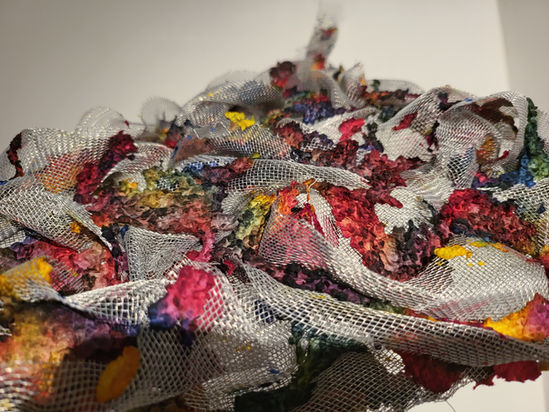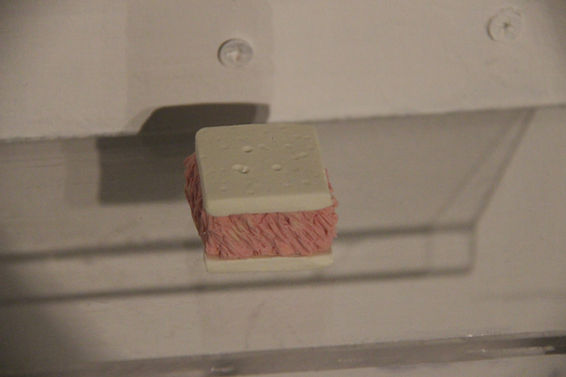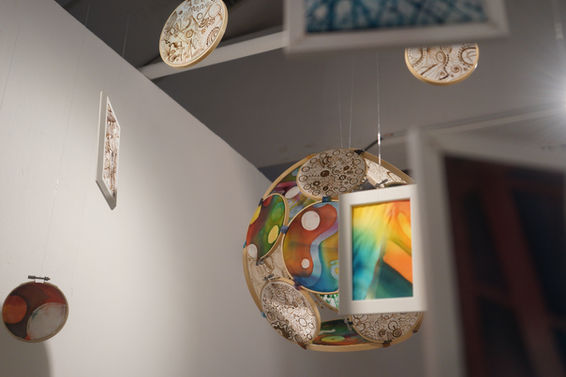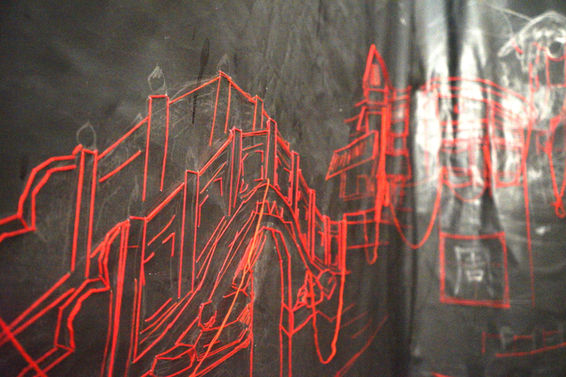who we are as it relates to where we are
Spatial Identities
The works throughout this exhibition explore the notions of “space” and “identity” as they relate to one another in different ways. The notion of “space” is significant, referring to both the gallery space as well as factual and fictional places. Every space and every individual has its own identity, and the artists explore how these identities relate to one another within our lives and experiences.

Sean
In exploring the dynamics of the intersections in life, Sean has taken an introspective approach to his art-making as he posits the idea that people grow through the turmoil that they go through. His work is a journey through life, and explores the process of how turmoil as well as ways of coping shapes one’s identity, manifested in a spatial form.
His installation piece beckons viewers towards the centre of the sculpture, where metal sinews tightly intertwine, so taut they seem to pull the walls together. Sean uses metal grids as a base for his sinewed structures to emphasise the juxtaposition between fluidity and rigidity. Inspired by MRI scans, Sean uses saturated colours to create papier mache on the sinews, injecting an organic vitality to his work. He connects growth and resistance, two seemingly dichotomous ideas, challenging the notion that they cannot exist at once.
click me to visit the map again
Sean favours exploiting the materiality of his works by truly mastering his chosen medium. Through his process work, one can see he exhausts all possibilities and experimentation, allowing him to achieve confident manipulation of his materials.
His works are usually abstract, and often sculptural, with a majority of them leaning towards contemplative and introspective themes.
Khern Hui
Khern Hui’s work shows her personal growth using food as metaphor. Her work explores this development through time manifested in its effects on objects. Following the concept of a seven-phase menu, Khern Hui presents 7 distinct stages of herself.
The main life-sized sandwich representing her current state is placed on a pedestal, framed by 7 miniature food sculptures displayed in a curve against the gallery wall. Viewers’ eyes are led through the curve, the objects’ heights mimicking the growth of a child documented through measurements on a wall, drawing them to inspect the delicate clay sculptures more closely. Each ingredient in the sandwiches represents a different aspect of her life, from her long-lived passion for art to her interest in mathematics and problem solving. Using her miniatures as a version of iconography, Khern Hui recreates different important elements of her personality and life experience through symbolism in a progression that flows through time, from abstraction to photorealism as the individual develops a more complex sense of self.
click me to visit the map again
Khern Hui’s works are often concerned with themes of personal identity, exploring the layers of oneself through representation and metaphor. She is often willing to bend the rules in inventive and imaginative ways in order to fulfil her artistic vision.
Her artworks are always incredibly intricate, and she takes great interest in mediums such as traditional painting, miniature sculpture and installation work.
Shafiqah
Shafiqah’s work acts as a spatial rendering of the growth and acceptance of one’s cultural identity. Her work is a physical representation of the metaphorical journey of moving from the linear form of thought of viewing one’s identity as distinct, individual pieces towards embracing it as an abstract, amalgamated whole.
She identifies textiles, as well as henna and other motifs as markers of cultural identity, and as such uses them as a medium to convey cultural heritage. The 3D forms of the artwork show her free and uninhibited state of mind as she goes through this journey. Shafiqah’s work gathers inspiration from Islamic architecture, and the shape of her work adds a ritualistic element to walking through it, allowing the viewer to follow her on her journey. The 3 layers of the work represent the journey of understanding one’s identity as split into 3 stages: premature, intermediate and final acceptance. The transition from deeper hues to brighter, more vibrant colours connote acceptance and understanding of separate cultural identities brought together. The shapes and motifs within her work change as the identity begins to concretise, with more curvilinear lines and circular shapes coming into play.
Her work implores viewers to walk along a similar journey and embrace their own cultural identities, especially in a world today that is so concerned with identity politics.
click me to visit the map again
Shafiqah’s works often centre around her cultural identity. Coming from a background of two separate cultures, she uses art as a way to reconcile and celebrate the beauty of both parts of her identity. She favours abstract and intricate patterning and motifs, often referencing her roots. With a background in designing and applying henna designs, she is able to create, draw or paint her own textiles in her works with familiarity and ease.
Joelle
Joelle’s work reflects dance as an important part of her identity through a performance artwork and installation piece. The performance aspect of her work is a dance carefully choreographed by the artist herself, showing her desire for reconciliation with her mother in the face of conflicting personal values. It involves a specially crafted dance floor, costume, as well as the traditional pigment of Chinese ink. Through this, the artist becomes a part of the artwork, just as her passion for both dance and art are an integral part of her own person.
The work is documented in a video of the performance, as well as an installation of photographs displayed within the walls of the make-shift dance studio, following the gestures made by the artist. Both the dance floor and costume include elements related to her personal experiences as a dancer, such as receipts and certificates from her lessons. The installation stands frozen in time within the art gallery, the remnants of her choreography splashed onto the walls in midnight ink splotches. Joelle also arranged the soundtrack which plays alongside the work, including recordings of her own voice and her mother’s voice, which tells her personal story. These aspects all suggest continuity, and the significance of persevering on her journey.
Her work is ultimately an exercise in, and plea for, empathy and reconciliation between her personal identity and the environment, be it as it relates to external circumstances or the desires of other individuals.
click me to visit the map again
Joelle has a deep passion for both art-making and dance, stemming from how she is able to express herself through both mediums. Many of her artworks explore her relationship with dance, as well as how it affects her relationships with those around her.
Joelle’s works have often taken the form of drawings, but she chose performance art for her A level work for its ability to allow her to express herself more freely.
Bronte
Bronte’s work explores escapism as a means through which individuals cope with changes in personal identity in the real world: by constructing an idealised self and idealised environment (be it spatial or social). Illusion is greatly used to manipulate depth and space, combining 3D and 2D elements to create the physical manifestation of a fantasy world, making the viewer feel as though they might be able to step into the world before them.
The exterior of the box takes the form of a whirlwind of book pages, sweeping the viewer up into the world that has formed within. The peep-hole allows viewers to peer through a portal into an intimate, fantastical reality of Bronte’s own making. Handcrafted miniature books are placed on bookshelves lining the inner walls of the box, representing the use of literature and other forms of storytelling to construct worlds which we may escape.
As the viewer’s eyes are drawn towards the digital illustration of a conservatory seen through a doorway, the viewer is given a sense of transition from reality and the physical, to the ethereal and emotional that often inhabit the world of escapism. The interior design of the conservatory includes patterns and designs inspired by the artist’s favoured childhood toy, representing comfort and innocence. These elements, as well as the lived-in feel of the miniature home makes the fantasy space introspective and reflective of the artist’s own and also every person’s desire to be comforted at one point or another in their lives in the face of reality.
In the artwork, while there is evidence of the artist’s persona’s presence in the world, she is missing in the work itself. instead a holographic companion remains forever pacing within this imagined space, as if waiting for someone who is yet to appear. The work acts as a reminder that regardless of how you change, or how the world changes around you, your place of comfort in fantasy will always be there, waiting for your return.
click me to visit the map again
Bronte usually works in illustrative mediums, but took on the challenge of creating a sculptural work for her A level art piece. Her work is largely concerned with themes of escapism and fantasy, and she takes great interest in media art, such as concept art and environmental design. When she’s not creating her next art piece for school, one can often find her creating fan art and working on commissioned illustrations.
Yusha
Yusha’s work is centred around the concept of one’s home as seen through the lens of one’s own memory: idealised and tinged with nostalgia. She eliminates people in capturing the essence of home, and invites the solitary viewer into a room of memories merged with imagination. Her work acts as a spatial representation of what it feels like to remember.
Her work exists at 3 levels, each following the eyeline of an individual at different stages of their life, showing growth from childhood into adulthood, and how memories may shift as we age. Having darkened canvas lining walls with the landscape only illustrated through graphite drawings and red string is strongly representative of the haziness of memories, with the string alluding to the red thread of fate - representing life and good fortune. The red string as a bold outline also highlights two aspects of remembering - the presence of a strong emotion and the most meaningful parts within a memory.
The imagery of the whale symbolises her exploration and voyage into the future, but also highlights the solitary nature of that journey. The whale is illustrated with only graphite against the dark canvas, indicating untold stories and aspirations for the next stage of her life.
Yusha has left the needle used to sew the red string throughout her work hanging on the end of the thread, signifying the continuation of both the individual’s life and the stories held within these places.
click me to visit the map again
Yusha’s works find their solid foundation in compelling ideas related to her personal background and life experiences, as well as how these things have shaped her as an individual. She is able to develop and explore these ideas with fluidity, while still staying true to her personal convictions. Her works often encompass a mixture of traditional elements as well as motifs from her personal life, making them significant to both artist and audience.
Grace
Grace’s work is heavily concerned with the sensory observation of the world, specifically focusing on sound and sight. The work acts as an exploration of how the identity of a space is built through individual auditory and visual elements. By recreating these signifiers of identity in an abstracted form within the gallery space, Grace has rewritten the spatial identity of her area of the gallery to encompass a separate location, allowing her to transport viewers to the location of her choosing - her neighbourhood. Not only does her use of sound give us a sense of the physical environment of the neighbourhood, but also the lively atmosphere and people within the space that give the space its identity.
The cone shaped elements are visually representative of sound, bringing to mind the image of a megaphone, acting as a sort of cylindrical kaleidoscope of sight and sound. The shapes of each cone are significant in relation to the types of sound one might hear, as are the abstract patterns colouring each cone. The individual comic caricatures of people, transport and wildlife in the neighbourhood also give visual clues as to where these sounds come from, and help to paint a greater picture of the environment.
click me to visit the map again
Grace likes to observe her surroundings and recompose them such that her audience may view the world in a realistic and colourful perspective. Her favourite subject matter is home, whether as places, people or objects.
Her works are often illustrative, taking the form of comics or animation. She enjoys creating characters and capturing moments in her unique art style.
Yi Zhen
Yi Zhen’s work was born from a search to figure out what home feels like. She specifies that home is not a location, but rather any space can be made into a home through its atmosphere, and the universal nature of home as a place of security and relaxation.
She constructs a space that is supposed to emulate the feeling of a home, one that is customisable to the individual view through the ability to interact with her artwork. Yi Zhen acknowledges the notion that each home is different for each individual, and as such the interactive aspect of allowing the viewer to sit within her artwork allows each viewer a singular experience. The act of taking one’s shoes off to enter the cordoned off area is ritualistic, as if entering a temple or other religious space.
The organic shapes within her work suggest gathering together, the 8-shaped pillows being representative of family members that act as a support system. Mellow colours connote structure, support and sobriety, contrasting with the soft, playful nature of the seats’ shape, while sponge patterns along the work reference individual responsibilities that uphold a home. Finally, she includes a label in the fabric structure that not only acts as a representation of the artists’ touch, but also takes the form of a talisman, and acts as a blessing from her to viewers
click me to visit the map again



















































































































